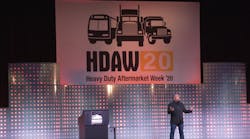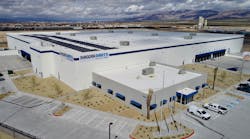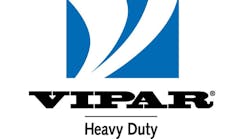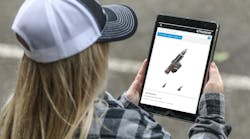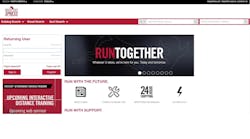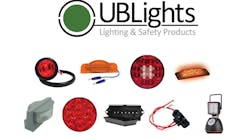Companies increasingly are getting involved in customized manufacturing that will produce a more highly spec'd vehicle.
Many fleets and individuals want the ride performance of their light- to medium-duty vehicle to be similar to their automobile. The missing element is air. In most cases, air-suspension systems can easily fix ride, handling, and loading-convenience issues.
It used to be difficult to get a product that was close to an OEM installation or design in the aftermarket, but not anymore.
For example, Link Manufacturing Ltd designs, manufactures, and markets primary suspensions for ambulances, shuttle buses, tower haulers, and specialty vehicle applications where improved ride, handling, and ease of vehicle loading are important.
Link, based in Sioux Center, Iowa, designs and delivers primary air-suspension products for Dodge, Ford, GMC, Hino, and Sterling medium-duty product lines. Even though Link has a factory position with one of the manufacturers, Link has been able to offer an offline solution by working closely with the OEM product managers, body builders, upfitters, and fleet managers to ensure the product performs at a level that is comparable to an OEM-installed, first-fit product.
“A lot of it is driven by where we see the opportunities,” says Gordon Virginski, OEM sales manager. “We look at mainly hydraulic-brake vehicles that don't have a compressed-air source. People will still want an air-ride suspension. They will come to us and say, ‘We're interested in air for a better ride.’ Maybe the driver has to do different things. He has more requirements, so they want to lower the vehicle. In that case, we can dump the system down to the bumpers with the air suspension, so it gives them better utilization of the vehicle. We look at various applications. We've done them for ambulances, shuttle buses, people towing large vehicles.”
Bill Ott, Link's director of engineering, says they work directly with CAD data from the OEM, design their prototype or concept, and use that to simulate the vehicle in software. From there, they calculate the loads that the suspension parts will experience, then take the results and perform an FEA analysis on the parts, including checking the vehicle frame stresses. Prototypes are then built and tested in the lab, on the road, and at the test track.
Rigorous testing
Link's testing equipment includes an MTS suspension performance test station, MTS component test station, National Instruments Data Acquisitions equipment, fatigue test equipment, pull-apart test station, and height control valve test station.
Virginski says sound processes are the key to success. They deliver every kit with the detailed parts and installation specifications that ensure each procedure is meeting Link's TS16949 processes. He says many people refer to this type of procedure and offering as an “aftermarket product,” but Link thinks differently, building these products and systems just as if they were an OEM first-fit installation, so all suspensions are customized and built for the specific vehicle.
“The days of an aftermarket product being just a will-fit are over,” Virginski says. “If you are going to supply a suspension for a vehicle, it's a critical component. There is no room for error, as these suspensions are used in severe applications such as ambulances and shuttle buses. You're going to go through all the testing, whether it's at Altoona or Reading or out in the desert. We use a truck simulator to get data acquisition so we get data back as to how the vehicle is reacting under changes in load.”
They'll take it to a test track, whether it's at the Altoona Bus Testing and Research Center in Pennsylvania, the Arizona Proving Grounds, or Bosch Proving Grounds in Indiana. They'll test dynamic ride and handling, where they fine-tune the shock absorbers and sway bars.
That's especially important for ambulances, which require high-speed evasive maneuvering. The tests include putting an ambulance suspension through a slalom course at 30-35 mph to ensure not only ride but handling is accomplished.
“I've done truck parts in sulfur mines, where there's exposure to sulfuric acid and corrosion,” Ott says. “I've done refuse packers, where they operated at twice their rated load. The ambulance industry is probably the hardest on equipment that I've ever seen. They're a very different application, and they admit that. They don't have time to fool around when an emergency patient is on board. A speed bump gets in the way? The heck with it. It's a difficult environment, particularly for suspensions.”
He said one of Link's customers, TurtleTop, used a GM chassis and a Link suspension to pass Altoona's 10-year, 350,000-mile life test.
“It's a requirement for a coach chassis,” he said. “Most of the federal or state contracts for shuttle buses will require passing that test. It's a torture test. You break many parts on a vehicle getting through that test. We've used that in our latest designs for ambulances. Very few people in our part of the industry do that.”
Ott says Link takes a vehicle to durability events — such as Inverted Chatter Bumps, Impact Bumps, Undulating Road, Resonance Road, and Staggered Bump Events — and has the vehicle instrumented.
“We measure the loads and stresses in frames,” he said. “We bring all the information back to the lab, do lab testing on the components to make sure we have satisfactory life. And then we release the design. Then we take another three months and validate all of our tooling and production methods to Six Sigma standards. Then we're ready for production.
“We design the suspension and then work with an installer. We have a group we've been working with. We certify them. We do training with them and audit their criteria. We look for people who have the capability to put an air suspension on. That's where we work through some of the OEM's ship-through companies. It could also be a pool-type customer in GM or Ford. Hino's actually putting our suspension online at the facility in Woodstock.”
Ship-through
National Truck Equipment Association (NTEA) technical services director Steve Spata is secretary for the Ambulance Manufacturers Division (AMD) and Mid-Size Bus Manufacturers Association (MSBMA), affiliate divisions of the NTEA. He says many of those groups' members are suppliers involved in the ship-through process.
“It's a good system,” he said. “It's been used for all kinds of commercial upfits. A lot of ambulance and bus manufacturers are taking advantage of it just because air ride is becoming more mainstream than the factory steel-spring suspension. It gives a more comfortable ride, especially if you're laying in the back of ambulance. You don't want to be bouncing around when somebody's trying to put an IV in your arm.
“They've been used to get ambulances to meet load height requirements so they would have ability to dump air bags to get the back end of the ambulance down if they're loading a cot.”
He says he expects offline suspension modifications to increase.
“I wouldn't be surprised if we see more factory programs,” he says. “That's usually the leading indicator — when companies like Ford and GM establish ship-through programs for it. If they start seeing the volume, they start asking the question, ‘Why aren't we doing it ourselves? We'll offer our own OEM air-ride suspension. If there's enough of a take rate, they'll do it.
“With the ship-through process, something that's relatively low volume that would be cost-prohibitive — if not logistically a problem — to do at a plant can have some OEM-quality representation behind the upfit, but yet still be able to have an option available to the market that's not some super-high-volume take rate. It's a little of the best of both worlds.”

